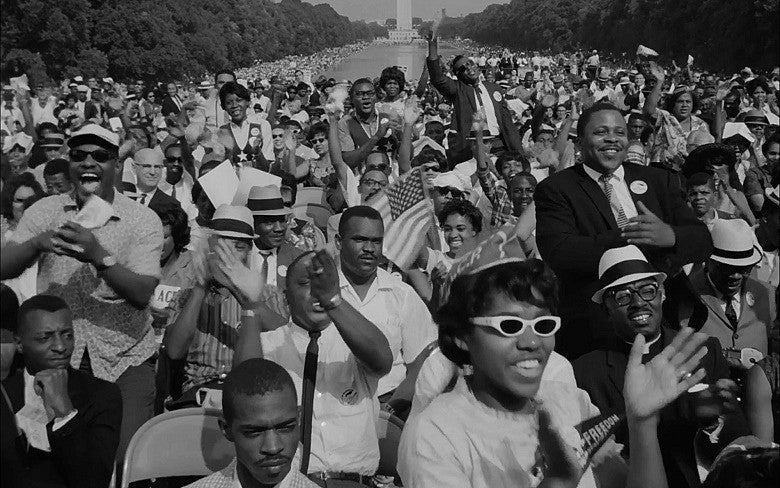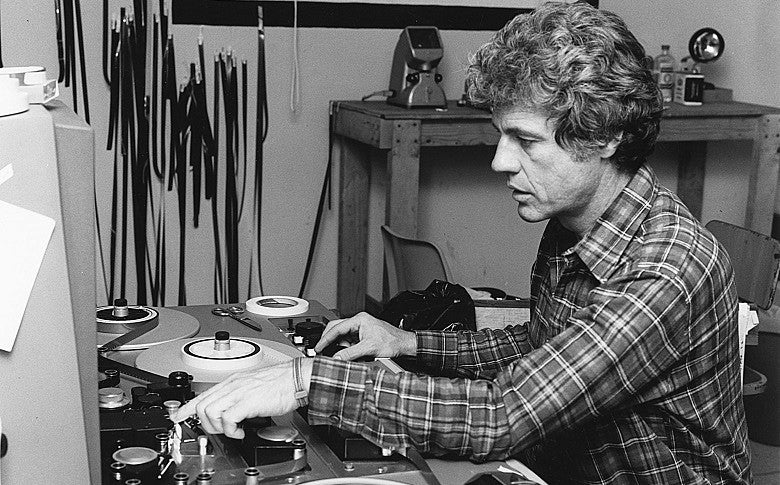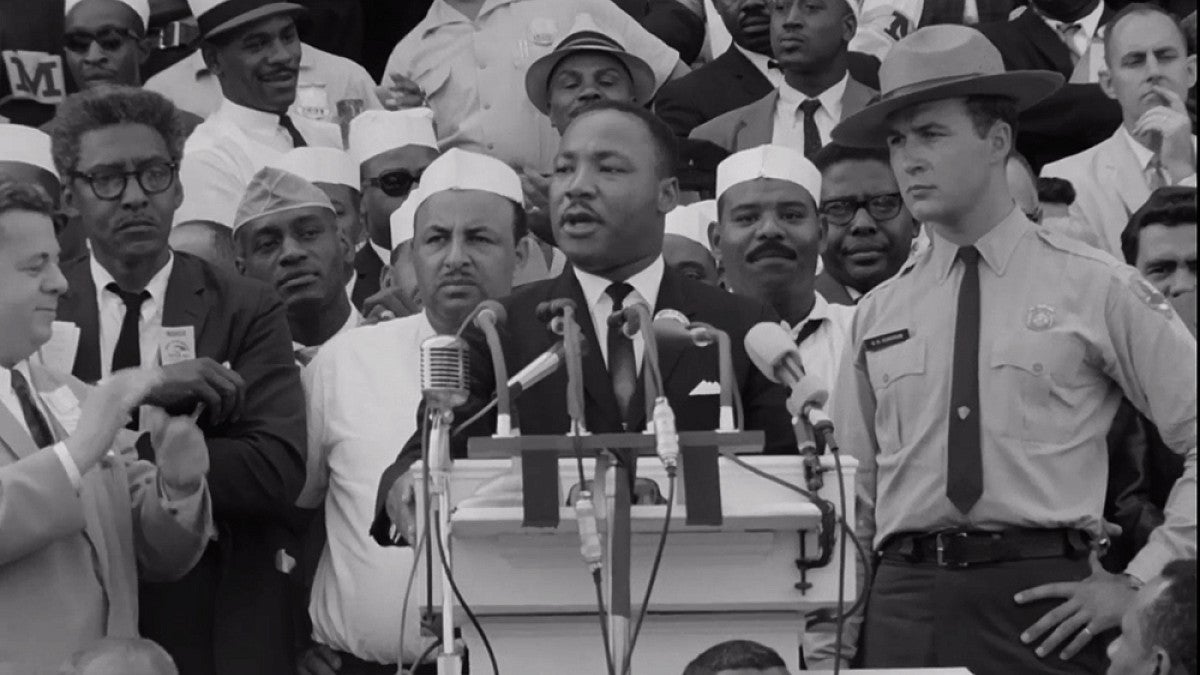A new digital exhibition illuminates the making of 'The March,' a landmark documentary of the period, and the film’s creator, UO grad James Blue.
On August 28, 1963, the eyes, ears and conscience of the nation turned toward its Capitol. The focus of attention was not on politics as usual, but a remarkable gathering of people united in a common cause.
More than 200,000 took part in the March on Washington for Jobs and Freedom. Organized by black leaders and attracting a majority-black crowd of participants, it was one of the largest rallies for human rights in U.S. history. At its climax, a television audience of millions tuned in as Martin Luther King Jr. ascended the steps of the Lincoln Memorial and delivered the stirring oratory that would go down for the ages as his “I Have a Dream” speech.
Among the marchers was James Blue, a 1953 University of Oregon graduate. An up-and-coming filmmaker whose formidable talent had already been recognized with the Critic’s Prize at the 1962 Cannes Film Festival, Blue was subsequently hired by John F. Kennedy’s United States Information Agency to create a documentary about the civil rights movement that would be distributed to embassies throughout the world.
With support from the Andrew W. Mellon Foundation, the film is now the centerpiece of a major new digital project by UO faculty members, staff and students that digs deeper into Blue's legacy to engage a new generation with the filmmaker's work. Blue died in 1980 at age 49.
“Brilliant” and “underserved” are two words used by David Frank, professor of rhetoric with the UO's Robert D. Clark Honors College, to describe Blue’s award-winning film “The March,” which was enshrined in the National Archives in 2013.

“The film tells the truth about American apartheid and also offers a vision of how it might be overcome,” Frank said. “It acknowledges contradictions in the American soul and the Constitution. Both King in his speech and Blue in his narration condemn racism and condemn the participation of America’s founding fathers in slavery, but the film also celebrates the possibility of King’s dream being realized.”
A longtime admirer of King’s legacy and a committed advocate for social justice, Frank is the creative force behind the new project, aimed at raising awareness of Blue and unpacking the history of the civil rights movement for a new generation of teachers and learners. Launching this week, “The March” digital exhibition offers a unique and immersive window into the epochal events of Aug. 28, 1963.
“Professor Frank’s work builds upon the James Blue Project, an existing collaboration between the UO Libraries and the Jordan Schnitzer Museum of Art,” said Adriene Lim, dean of libraries and Philip H. Knight Chair. “He has helped us create a vibrant new resource that will be instrumental in teaching and learning about civil rights and social justice, and serves as a model for extending and deepening the engagement of users with our joint collections and services.”
Frank explained that he had initially planned to write a book about Blue and “The March,” but he then became aware of the Mellon faculty fellows grant that was offered by the UO Libraries and the Jordan Schnitzer Museum of Art. Inspired by a conversation with Richard Herskowitz, the museum’s curator of media arts, he began to envision the myriad possibilities of presenting his research in a digital format.
This would be new territory for Frank, so he was grateful to be selected as one of three inaugural Mellon faculty fellows and to be afforded resources and expertise from the library and museum worlds.
“I had never created a website and I am not a digital humanist,” Frank explained. “So it took Jenny Kreiger and her graduate assistants to teach me how to take printed materials and fetch out the advantages that digital technology has to offer.”

RELATED LINKS
Go to the digital exhibit on "The March"
Watch other James Blue movies (including his UO student films)
Visit the James Blue Papers held by UO Libraries’ Special Collections and University Archives
Attend Jan. 20 screening of “The March” hosted by Eugene-Springfield NAACP
Read “Witnessing History,” a feature article about James Blue and “The March”
Read “Rhapsody in Blue,” a feature article about Blue’s life, legacy and archives (PDF)
A classical archaeologist with hands-on experience in digital research methods, Kreiger serves as the Mellon postdoctoral scholar in library-museum collaboration. Her role is to provide project management and digital communications expertise to assist the Mellon faculty fellows in bringing their proposals to fruition.
“Collaboration is essential for fieldwork in archaeology, and I feel like I am coming to this as a professional collaborator, someone whose job is to listen and to translate across disciplines and domains, to help people work together by facilitating communications,” she said.
From graduate assistants Tom Fischer and Liam Maher to staff in the library’s digital scholarship services department, Kreiger credits many people with helping take “The March” from an idea on the drawing board to a live, public resource on the worldwide web.
In demonstrating the features and functionality of their digital exhibition, Kreiger and Frank pointed to highlights that include a new and improved transcript of the film’s content; a wealth of background information about the many gospel songs and musical performers that play a prominent role in the narrative; and archival audio recordings of President Lyndon B. Johnson’s phone conversations with political stakeholders as they vetted Blue’s film and consolidated support for the 1964 Civil Rights Act.
“Unlike with a book, a person can move more easily through the content in the order of their choice, even if they take a path other than the straight and linear,” Kreiger said. “My hope for the project, content aside, is that it will inspire other scholars to consider digital exhibitions as a form of scholarly communication, a way to present their research to much broader audiences.”
Frank said he also hopes “The March” will help create renewed awareness of the 1960s civil rights movement for a generation of young learners who are coming to college with a passion for social justice advocacy but often lack historical context and knowledge of the important groundwork done by previous generations.
He also hopes that many new fans will discover Blue’s cinematic gifts and be inspired by his journey from troubled, introverted high-school student to world-renowned filmmaker. A key part of that personal evolution was his time as a student at the UO.

“This was a remarkable human being who was a product of Oregon education,” Frank said. “At the University of Oregon, he had professors who recognized in him a genius and fostered his talents. They helped him realize his potential. It is the best outcome of a liberal arts education, and in the honors college I still get to see it happening all the time.”
Jill Hartz, executive director of the art museum, lauded “The March” digital exhibit as the latest advancement by UO’s James Blue research interest group, which has already produced a biographical documentary, “Citizen Blue,” by School of Journalism and Communication faculty member Daniel Miller and raised funds for the restoration of Blue’s award-winning feature film, “The Olive Trees of Justice.’’
“For the past five years, thanks to Richard Herskowitz and the libraries' special collections archivists, we’ve been able to foreground Blue’s work in our Schnitzer Cinema series and initiated the James Blue project,” Hartz said. “Now, with generous Mellon support, professor Frank, a Blue project member, has added to our appreciation of Oregon’s finest documentary filmmaker by showing online the full artistic and historical significance of his civil rights masterpiece.”
—By Jason Stone, University Communications


